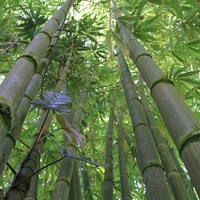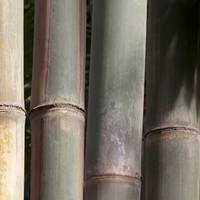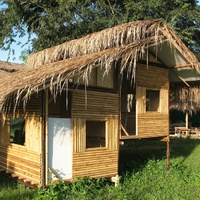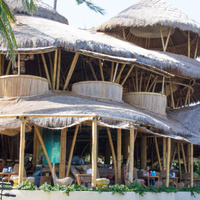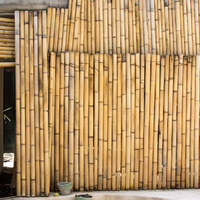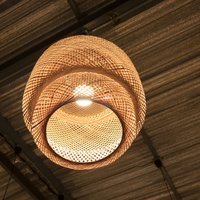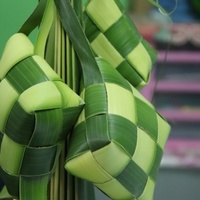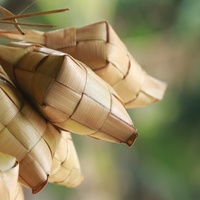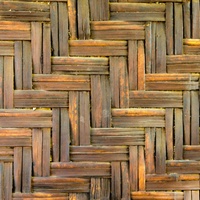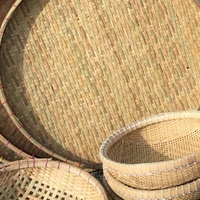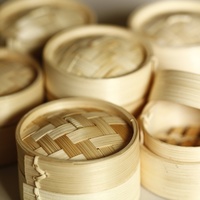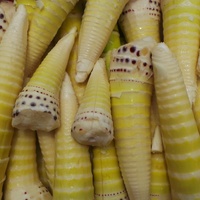Common name: Giant Bamboo
Other common names: Asper Bamboo, Indonesian Asper, Rough Bamboo, Rough Asper
Description
Giant Bamboo is a clumping bamboo cultivated for its woody stems and edible shoots.
Originating in Southeast Asia, its natural range extends across parts of Thailand and Malaysia. Nowadays, it is introduced and cultivated in other Southeast Asian regions and places much farther away, including Sri Lanka, Madagascar and warm parts of China, Australia and the United States.
A member of the grass family, Giant Bamboo is comprised of underground rhizomes sprouting clumps of cane-like stems. The stems grow fast, adding 10 cm (4 in) or more in height per day and, when mature, are 20 to 30 m (65 to 100 ft) tall with a diameter of 8 to 20 cm (3 to 8 in).
Each clump has many stems at different stages of maturity, and those that are mature form tall stands that sway and creak in the wind. Like other grasses, the stems are jointed but made of a rigid woody material. The surface is dark green and smooth between the joints, and the inside is hollow.
Flowering is rare or sporadic in most bamboos and only occurs once every few decades. As a result, very little is known about the flowering and seeding habit of Giant Bamboo except that when flowering does occur, the plant usually dies after seeding.
Use
More commonly known as culms, the mature woody stems are harvested and used whole or split to make various bamboo-wood products.
Large diameter culms are used whole in construction, including scaffolding and structural components such as beams and poles in buildings. Small diameter culms are made into cane furniture, musical instruments and similar articles.
Culms selected for processing into bamboo-wood products are first split into either laths, splits, sticks or are sliced into veneer, depending on the product to be made.
Splits are long, thin strips that are flexible enough to be woven into baskets, mats, panels, screens or furniture or steam-bent into curved pieces.
Lathes are full-thickness bamboo splits that are shaped, planed, assembled and glued into boards. The boards are then cut and shaped to make finished products such as doors, window frames, panels and parquet flooring.
Sticks refer to cutting and shaping bamboo pieces, usually by machine, into items such as chopsticks and kitchen utensils.
Veneers are thinly sliced, highly polished bamboo pieces that add a decorative surface to furniture, surfboards, skateboards and other articles.
Bamboo wood is also converted into charcoal fuel, medicines and materials used in industry. Such as materials to filter and purify liquids and gases and absorb excess moisture. Bamboo charcoal as fuel burns hot and clean, making it an excellent substitute for wood charcoal in cooking and barbecuing. It is usually available either as regular charcoal or briquettes and is produced from culms grown for the purpose and from waste, including sawdust.
Activated charcoal, a finely porous and pure charcoal produced under controlled conditions, is made mainly from bamboo wood and coconut (Cocos nucifera) shells. It is used by industry in air, gas and alcohol filtration, chemical and metal purification, excess moisture absorption, and sewage treatment. Activated charcoal is also used in medicine to treat flatulence, diarrhoea, indigestion and drug overdose. And more recently, it has been touted as a teeth whitening agent.
Bamboo wood comprises long, absorbent fibres that substitute for other fibres in clothing and wood in paper pulp. The pulp made from it produces paper with a high tear strength, similar to paper made from hardwoods. These properties make it suitable for moulding it into disposable, bio-degradable items such as paper cups, plates, fast-food containers, and a range of other manufactured items currently using synthetic materials such as polystyrene.
Giant Bamboo is one of only a few tropical bamboos cultivated for its edible shoots. Other warm climate bamboo species suitable for shoot cultivation include Sweet Bamboo (Dendrocalamus latiflorus) and Giant Timber Bamboo (Bambusa oldhamii). Although commonly canned, the shoots are also ideal for fresh consumption but have high cyanide concentrations and must first be boiled in water for 15 to 20 minutes before being eaten. In Southeast Asia, bamboo shoots are also commonly dried and pickled to preserve and flavour them. Giant Bamboo shoots have a crisp, apple-like texture. They are slightly less bitter than other edible bamboo species and ideal for salads and other summer dishes.
Clumping bamboos are planted on steeply sloping hillsides and along river banks to prevent soil erosion and do this well by growing quickly and forming dense clumps. Established bamboo clumps also provide shade and can serve as a windbreak or privacy screen.
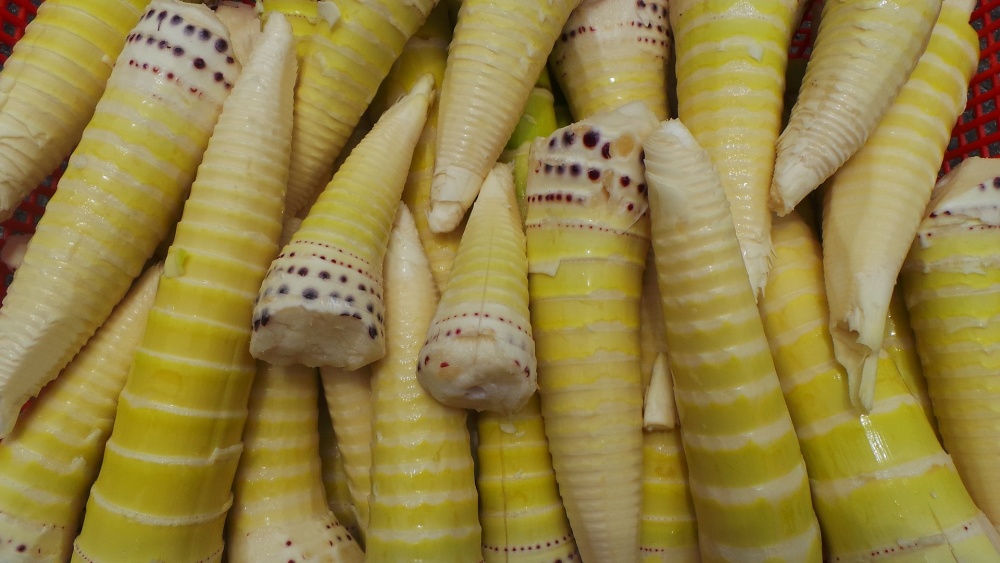
Bamboo shoots
Climate
Giant Bamboo grows naturally in humid subtropical and tropical climates, generally areas with annual lows of 14 to 25°C, annual highs of 24 to 36°C, annual rainfall of 1200 to 6000 mm and a dry season of 5 months or less. It is most productive in tropical areas receiving annual rainfall of 1400 mm or more. Still, it is also successfully cultivated in drier areas with irrigation.
Growing
New plants can be started from cuttings, offsets (one to two-year-old culms) or rhizome divisions. Still, tissue culture is quickly taking over as the preferred propagation method and gives excellent results. Seed can also be used but are rarely available and can result in offspring with significant variation in their characteristics.
Giant Bamboo performs best on organically rich, free-draining clay-loam, loam, sandy-loam and loamy-sand soils of a moderately acid to neutral nature, generally with a pH of 5.0 to 7.5 and on sites with full to partial sun exposure. It has poor tolerance to slow-draining, sticky soils or depleted shallow soils with little organic matter.
Shoots for eating are harvested from clumps that are at least three to four years old. Early- or over-harvesting can result in low productivity over the life of the plant. As a general rule, shoots are harvested soon after they emerge and when their height is about three times the width at the base.
Average yields for unmanaged mature culms is estimated at 1,000 to 2,000 kgs per hectare (892 to 1,784 pounds per acre) per year but can be up to ten or twenty times that in intensive cultivation systems. Yields of fresh Giant Bamboo shoots grown in Australia averages around 9,000 kgs per hectare per year, the equivalent of 8,030 pounds per acre.
Giant Bamboo characteristics and uses vary between the different varieties or cultivars. Well-known varieties include 'Phai Tong Keo', a cultivar from Thailand commonly cultivated for its edible shoots and 'Betung Hitam' (aka 'Black Asper), a black stemmed cultivar from Indonesia, which also produces edible shoots.
Problem features
The shoots contain high levels of cyanogen, a poisonous cyanide-producing compound that must be removed by cooking before eating. High levels of cyanogens are also present in the tubers of Cassava (Manihot esculenta).
Despite its widespread cultivation, there does not appear to be any records of escape and naturalisation anywhere. It is assessed as a low weed risk species for Hawaii by the Hawaii Pacific Weed Risk Assessment (HPWRA) project.
Where it grows
References
Books
-
Byrne, T. & Bourke, M. & Salvin, S. 2004, The new crop industries handbook, Rural Industries Research and Development Corporation (RIRDC), Canberra, Australia
-
Elevitch, C. R. & Thaman, R. R. 2011, Specialty crops for Pacific islands, 1st ed, Permanent Agriculture Resources, Hawaii
-
Hu, S. 2005, Food plants of China, Chinese University Press, Hong Kong
-
Jensen, M. 1999, Trees commonly cultivated in Southeast Asia : an illustrated field guide, 2nd ed., Food and Agricultural Organisation of the United Nations (FAO) Regional Office for Asia and the Pacific (RAP), Bangkok
-
Lobovikov, M. 2007, World bamboo resources : a thematic study prepared in the framework of the Global Forest Resources Assessment 2005. Food and Agriculture Organization of the United Nations (FAO), Rome
-
Luna, R. K 1996, Plantation trees, International Book Distributors, Dehradun, Uttarakhand
-
Mollison, B. 1993, The permaculture book of ferment and human nutrition, Tagari Publications, Tyalgum, New South Wales
-
Norrington, L. & Campbell, C. 2001, Tropical food gardens : a guide to growing fruit, herbs and vegetables in tropical and sub-tropical climates, Bloomings Books, Hawthorn, Victoria
-
Randall, R. P. 2002, A global compendium of weeds, R.G. and F.J. Richardson Press, Melbourne
-
Randall, R. P. 2007, The introduced flora of Australia and its weed status, Cooperative Research Centre for Australian Weed Management, Glen Osmond, South Australia
-
Roecklein, J. C & Leung, P.S. 1987, A Profile of economic plants, Transaction Books, New Brunswick, New Jersey
-
Rubatzky, V. E. & Yamaguchi, M. 1997, World vegetables : principles, production, and nutritive values, 2nd ed., Chapman & Hall, New York
-
Toensmeier, E. 2007, Perennial Vegetables : From Artichokes to Zuiki Taro, A Gardener's Guide to Over 100 Delicious and Easy to Grow Edibles, White River Junction, Chelsea Green Publishing, Vermont
-
Van Wyk, B. E. 2005, Food plants of the world: an illustrated guide, 1st ed., Timber Press, Portland, Oregon
